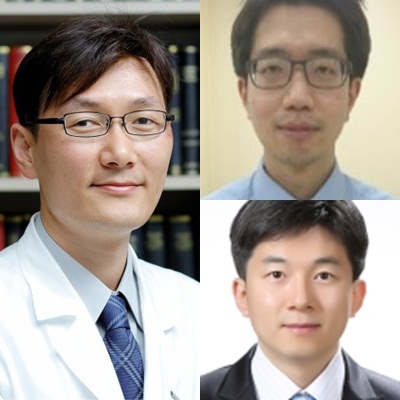글로벌 연구동향
핵의학
 PET/CT-Based Dosimetry in 90Y-Microsphere Selective Internal Radiation Therapy: Single Cohort Comparison With Pretreatment Planning on 99mTc-MAA Imaging and Correlation With Treatment Efficacy.
PET/CT-Based Dosimetry in 90Y-Microsphere Selective Internal Radiation Therapy: Single Cohort Comparison With Pretreatment Planning on 99mTc-MAA Imaging and Correlation With Treatment Efficacy.(서울의대: 송요성, 김효철*, 팽진철*)
- 출처
- Medicine (Baltimore)
- 등재일
- 2015 Jun
- 저널이슈번호
- 94(23):e945
- 내용

[Abstract]
Y PET/CT can be acquired after Y-microsphere selective radiation internal therapy (SIRT) to describe radioactivity distribution. We performed dosimetry using Y-microsphere PET/CT data to evaluate treatment efficacy and appropriateness of activity planning from Tc-MAA scan and SPECT/CT.Twenty-three patients with liver malignancy were included in the study. Tc-MAA was injected during planning angiography and whole body Tc-MAA scan and liver SPECT/CT were acquired. After SIRT using Y-resin microsphere, Y-microsphere PET/CT was acquired. A partition model (PM) using 4 compartments (tumor, intarget normal liver, out-target normal liver, and lung) was adopted, and absorbed dose to each compartment was calculated based on measurements from Tc-MAA SPECT/CT and Y-microsphere PET/CT, respectively, to be compared with each other. Progression-free survival (PFS) was evaluated in terms of tumor absorbed doses calculated by Tc-MAA SPECT/CT and Y-microsphere PET/CT results.Lung shunt fraction was overestimated on Tc-MAA scan compared with Y-microsphere PET/CT (0.060 ± 0.037 vs. 0.018 ± 0.026, P < 0.01). Tumor absorbed dose exhibited a close correlation between the results from Tc-MAA SPECT/CT and Y-microsphere PET/CT (r = 0.64, P < 0.01), although the result from Tc-MAA SPECT/CT was significantly lower than that from Y-microsphere PET/CT (135.4 ± 64.2 Gy vs. 185.0 ± 87.8 Gy, P < 0.01). Absorbed dose to in-target normal liver was overestimated on Tc-MAA SPECT/CT compared with PET/CT (62.6 ± 38.2 Gy vs. 45.2 ± 32.0 Gy, P = 0.02). Absorbed dose to out-target normal liver did not differ between Tc-MAA SPECT/CT and Y-microsphere PET/CT (P = 0.49). Patients with tumor absorbed dose >200 Gy on Y-microsphere PET/CT had longer PFS than those with tumor absorbed dose ≤200 Gy (286 ± 56 days vs. 92 ± 20 days, P = 0.046). Tumor absorbed dose calculated by Tc-MAA SPECT/CT was not a significant predictor for PFS.Activity planning based on Tc-MAA scan and SPECT/CT can be effectively used as a conservative method. Post-SIRT dosimetry based on Y-microsphere PET/CT is an effective method to predict treatment efficacy.
[Author information]
Song YS1, Paeng JC, Kim HC, Chung JW, Cheon GJ, Chung JK, Lee DS, Kang KW.
1 From the Department of Nuclear Medicine, Seoul National University Hospital (YSS, JCP, GJC, J-KC, DSL, KWK); Department of Nuclear Medicine, Seoul National University Bundang Hospital (YSS); and Department of Radiology, Seoul National University Hospital, Seoul, Korea (H-CK, JWC).
- 연구소개
- 본 연구는 서울대학교병원 핵의학과 팽진철 교수와 영상의학과 김효철 교수 팀의 공동연구로서 90Y-미소구(microsphere)를 이용한 방사선색전술 치료를 받은 간종양 환자들에서 SPECT/CT를 이용한 사전선량평가의 적정성과 시술 후 PET/CT를 이용한 선량평가의 필요성을 환자 예후의 관점에서 평가한 연구이다. 90Y-미소구 방사선색전술은 수술을 시행할 수 없는 간암 또는 간전이암 환자에서 좋은 효과를 보이는 치료법인데, 사전선량평가를 통한 적정투여방사능량 결정이 종양에 대한 충분한 치료효과와 정상조직의 방사선손상 예방을 위해 필수적이다. 현재는 실험적으로 투여방사능량을 결정하거나 평면영상을 이용한 간내 2-분획 모델을 이용한 사전선량평가가 시행되고 있는데 이 연구에서는 Tc-99m MAA SPECT/CT를 이용한 간내 3-분획 모델을 적용하여 사전선량평가를 시행하고, 이를 시술 후 시행한 90Y PET/CT로부터 구해진 종양 조직, 정상 간 조직, 폐의 흡수선량과 비교하였다. 연구 결과, SPECT/CT를 이용한 사전선량평가는 PET 결과와 좋은 상관관계를 보여 기존의 평면영상을 이용한 방법보다 더욱 좋은 사전선량평가법임을 증명하였다. 그러나, 90Y PET/CT 결과와 적지 않은 불일치도 있었으며, 특히 SPECT/CT 결과는 예후와의 관계가 유의하지 않았으나 90Y PET/CT에서 계산된 종양 조직 흡수선량 200 Gy를 기준으로 환자의 예후가 달라짐을 보여(그림), 시술 후 환자 평가 시 90Y PET/CT 시행이 필요함을 보였다. 본 연구는 90Y PET/CT를 이용한 선량측정과 환자의 예후 간 상관관계를 처음으로 규명한 데 의의가 있다.
- 덧글달기









